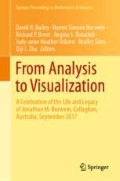Abstract
Though mathematicians invented the modern computer as a theoretical entity, and a few of them helped build the first modern digital computers, mathematicians as a whole lagged far behind scientists, engineers, and other professionals in actually using them (In this article, unless noted to the contrary, I use the term “mathematician” to refer to pure mathematicians, who focus on formulating and proving statements about abstract mathematical structures.). Recognizing that the field was in danger of falling too far behind, in May 1988, the American Mathematical Society launched a new section in its newsletter Notices, sent out to all members ten times a year, titled “Computers and Mathematics”. Its aim was to promote the use of computers by mathematicians and provide them with information about the many new mathematical software systems being developed. The section was initially edited by the Stanford mathematician Jon Barwise, who ran it until February 1991, after which the AMS asked me to take it over. I held the reins from the March 1991 issue until the AMS and I decided to end the special section in December 1994. That six-and-a-half-year run achieved the intended goal. By the time the special section wound up, the computer had become a staple tool for mathematicians, both in teaching and research.
How I learned to stop worrying and love the bomb,
subtitle to the 1964 movie Dr. Strangelove
Access this chapter
Tax calculation will be finalised at checkout
Purchases are for personal use only
Notes
- 1.
While the results of Turing, von Neumann, and Church gave a theoretical underpinning to the subsequent developments of computers, it is clear that the technology would have been developed anyway, and indeed such advances were already underway. For example, Konrad Zuse took out patents for computing devices in 1936 and 1941. And the ENIAC, 1943–46, was designed by engineers Eckert and Mauchly, before von Neumann became involved in the project. Moreover, theoretical and practical work on computing devices was done much earlier by Pascal (1642), Leibniz (1674), and Babbage (1822).
- 2.
The term “higher arithmetic” has acquired a special meaning in the mathematical world. That is not what I am referring to here.
- 3.
Making my title for this article a bit more than an irresistible play on words.
- 4.
Full disclosure. I was a member of Wolfram’s initial Mathematica Advisory Board in the products early years (we were all unpaid), so I naturally defaulted to using Wolfram products. But there were several CASs being developed around the same time, Maple, Matlab, Magma, Sage, etc.
References
Borwein, J.: Devlin, K,: The Computer as Crucible. AK Peters/CRC Press, Boca Raton (2008)
Ceruzzi, Paul E.: Computing: A Concise History. MIT Press, Cambridge (2012)
Devlin, K.: All the Mathematical Methods I Learned in My University Math Degree Became Obsolete in My Lifetime. Huffington Post (23 Jan 2017). https://www.huffingtonpost.com/entry/all-the-mathematical-methods-i-learned-in-my-university_us_58693ef9e4b014e7c72ee248
Devlin, K., Wilson, N.: Six-year index of “computers and mathematics”. Not. Am. Math. Soc. 42(2), 248–254 (1995). http://www.ams.org/journals/notices/199502/devlinsixyear.pdf
Dyson, G.: Turing’s Cathedral: The Origins of the Digital Universe. Vintage, Visalia (2012)
Wilson, R.: Four Colors Suffice: How the Map Problem Was Solved. Princeton University Press, Princeton (2014)
Author information
Authors and Affiliations
Corresponding author
Editor information
Editors and Affiliations
Rights and permissions
Copyright information
© 2020 Springer Nature Switzerland AG
About this paper
Cite this paper
Devlin, K. (2020). How Mathematicians Learned to Stop Worrying and Love the Computer. In: Bailey, D., et al. From Analysis to Visualization. JBCC 2017. Springer Proceedings in Mathematics & Statistics, vol 313. Springer, Cham. https://doi.org/10.1007/978-3-030-36568-4_8
Download citation
DOI: https://doi.org/10.1007/978-3-030-36568-4_8
Published:
Publisher Name: Springer, Cham
Print ISBN: 978-3-030-36567-7
Online ISBN: 978-3-030-36568-4
eBook Packages: Mathematics and StatisticsMathematics and Statistics (R0)

